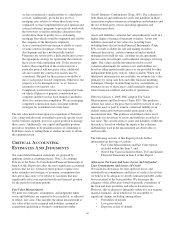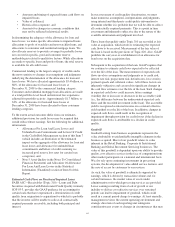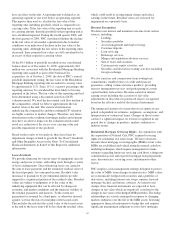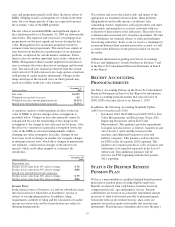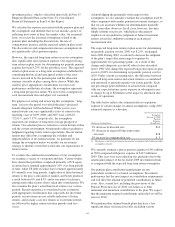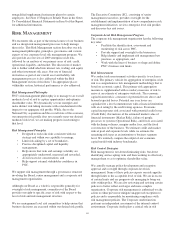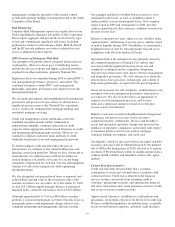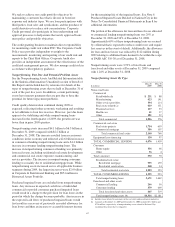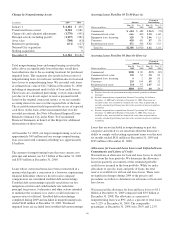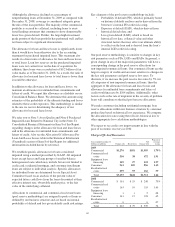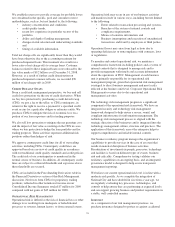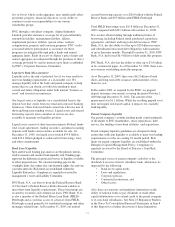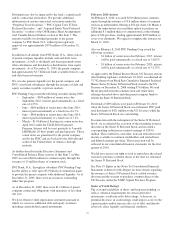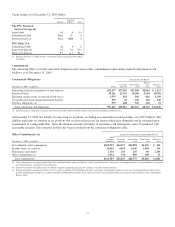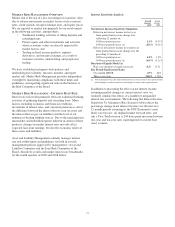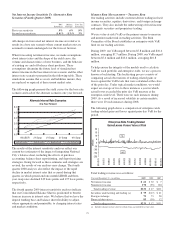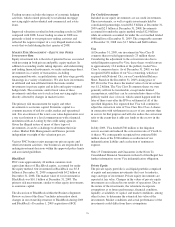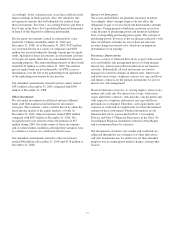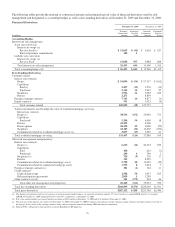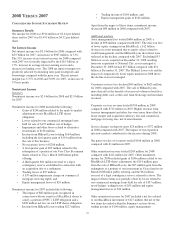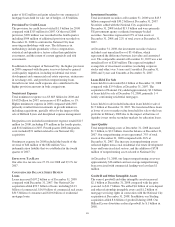PNC Bank 2009 Annual Report Download - page 74
Download and view the complete annual report
Please find page 74 of the 2009 PNC Bank annual report below. You can navigate through the pages in the report by either clicking on the pages listed below, or by using the keyword search tool below to find specific information within the annual report.We establish reserves to provide coverage for probable losses
not considered in the specific, pool and consumer reserve
methodologies, such as, but not limited to, the following:
• industry concentrations and conditions,
• credit quality trends,
• recent loss experience in particular sectors of the
portfolio,
• ability and depth of lending management,
• changes in risk selection and underwriting standards,
and
• timing of available information.
Total net charge-offs are significantly lower than they would
have been otherwise due to the accounting treatment for
purchased impaired loans. This treatment also results in a
lower ratio of net charge-offs to average loans. Customer
balances related to these impaired loans were reduced by the
fair value marks of $9.2 billion as of December 31, 2008.
However, as a result of further credit deterioration on
purchased impaired commercial loans, we recorded $90
million of net charge-offs in 2009.
C
REDIT
D
EFAULT
S
WAPS
From a credit risk management perspective, we buy and sell
credit loss protection via the use of credit derivatives. When
we buy loss protection by purchasing a credit default swap
(CDS), we pay a fee to the seller, or CDS counterparty, in
return for the right to receive a payment if a specified credit
event occurs for a particular obligor or reference entity. We
purchase CDSs to mitigate the risk of economic loss on a
portion of our loan exposures and for trading purposes.
We also sell loss protection to mitigate the net premium cost
and the impact of fair value accounting on the CDS in cases
where we buy protection to hedge the loan portfolio and for
trading purposes. These activities represent additional risk
positions rather than hedges of risk.
We approve counterparty credit lines for all of our trading
activities, including CDSs. Counterparty credit lines are
approved based on a review of credit quality in accordance
with our traditional credit quality standards and credit policies.
The credit risk of our counterparties is monitored in the
normal course of business. In addition, all counterparty credit
lines are subject to collateral thresholds and exposures above
these thresholds are secured.
CDSs are included in the Free-Standing Derivatives table in
the Financial Derivatives section of this Risk Management
discussion. Net losses from CDSs for proprietary trading
positions, reflected in other noninterest income on our
Consolidated Income Statement, totaled $7 million for 2009
compared with net gains of $45 million for 2008.
O
PERATIONAL
R
ISK
M
ANAGEMENT
Operational risk is defined as the risk of financial loss or other
damage to us resulting from inadequate or failed internal
processes or systems, human factors, or from external events.
Operational risk may occur in any of our business activities
and manifests itself in various ways, including but not limited
to the following:
• Errors related to transaction processing and systems,
• Breaches of the system of internal controls and
compliance requirements,
• Misuse of sensitive information, and
• Business interruptions and execution of unauthorized
transactions and fraud by employees or third parties.
Operational losses may arise from legal actions due to
operating deficiencies or noncompliance with contracts, laws
or regulations.
To monitor and control operational risk, we maintain a
comprehensive framework including policies and a system of
internal controls that is designed to manage risk and to
provide management with timely and accurate information
about the operations of PNC. Management at each business
unit is primarily responsible for its operational risk
management program, given that operational risk management
is integral to direct business management and most easily
effected at the business unit level. Corporate Operational Risk
Management oversees day-to-day operational risk
management activities.
The technology risk management program is a significant
component of the operational risk framework. We have an
integrated security and technology risk management
framework designed to help ensure a secure, sound, and
compliant infrastructure for information management. The
technology risk management process is aligned with the
strategic direction of the businesses and is integrated into the
technology management culture, structure and practices. The
application of this framework across the enterprise helps to
support comprehensive and reliable internal controls.
Our business resiliency program manages the organization’s
capabilities to provide services in the case of an event that
results in material disruption of business activities.
Prioritization of investments in people, processes, technology
and facilities is based on different types of events, business
risk and criticality. Comprehensive testing validates our
resiliency capabilities on an ongoing basis, and an integrated
governance model is designed to help assure transparent
management reporting.
We believe our current operational risk level is in line with a
moderate risk profile. As we complete the integration of
National City and have doubled in size from a year ago, we
are regularly evaluating key processes, technologies, and
controls to help ensure they are performing at expected levels,
and can support growing business and product requirements in
a stable, well controlled manner.
Insurance
As a component of our risk management practices, we
purchase insurance designed to protect us against accidental
70


